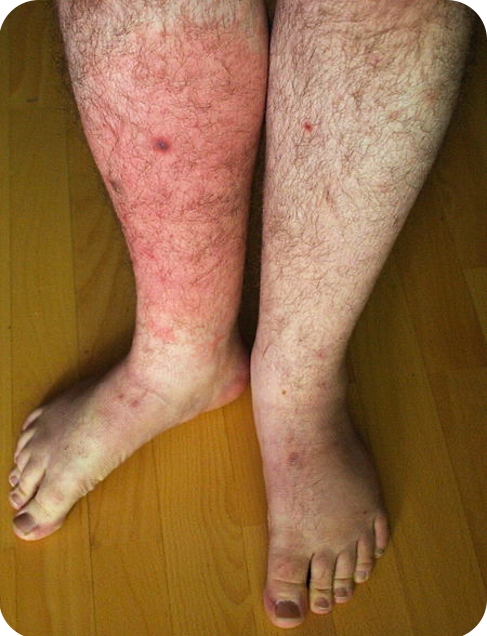Menu
All lymphedema patients have an increased risk of infection (cellulitis) in the affected body part. This is due to reduced immunity in the swollen limb. Although it doesn’t happen often, it’s important for lymphedema sufferers to be aware of the signs of infection and to seek prompt medical advice if one does occur.
Many infections arise from cuts, scrapes, or other injuries to the limb. It’s a good idea to follow the prevention tips in the LAQ brochure Living Well with Lymphedema. But if, despite these precautions, you develop the following signs and symptoms, please see your GP as soon as possible for assessment and prescription of antibiotics:

Sudden appearance of a rash with distinct red margins, discoloration and itching in the affected limb
Increased swelling
Fever or chills, increased skin temperature
Pain that may radiate into the armpit or groin
In addition to taking antibiotics, you should temporarily stop all lymphedema treatments, and only resume them when your doctor tells you to. The use of bandages, sleeves or compression stockings can be continued if this is comfortable for you (as the limb may remain painful for a few days). Some patients may need to take intravenous antibiotics in hospital if oral antibiotics do not quickly control symptoms, or if the infection is more severe.
In addition to prevention tips, proper care in the maintenance phase of lymphedema minimizes the risk of infection. Wear your compression garments (e.g., daywear, Velcro/alternative, nightwear, bandages), do your curative exercises, and follow your therapist’s advice. If swelling increases, consult your doctor or therapist to find out how to modify your program to regain good control.
Reference: McGill University Health Centre and Lymphedema Association of Quebec
Last updated August 2019
The Lymphedema Association of Québec provides support, education, and awareness to people living with lymphedema, as well as their families, friends, and healthcare professionals. We provide information and educate about lymphedema and its causes, risk reduction, and treatments for this chronic disease, and encourage scientific research leading to a cure.
Lymphedema Association of Québec
Therapeutic Support Program
1 866 979-2463
514 979-2463
Mailing address
CP 152, Bureau Chef Branch,
Saint-Hyacinthe,
QC, J2S 7B4
Telephone
1 866 979-2463 / 514 979-2463
Email
aql@infolympho.ca
Website
www.infolympho.ca
© 2023 Lymphedema Association of Québec. All rights reserved. | Credits